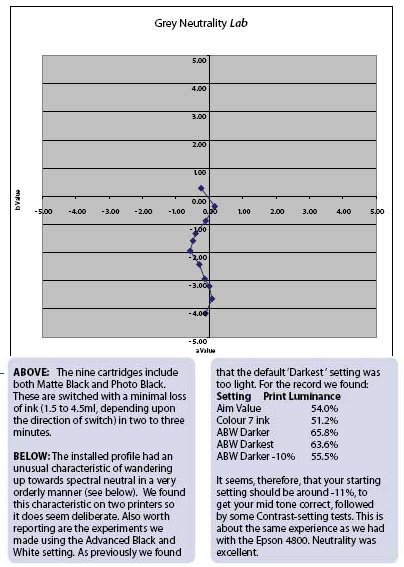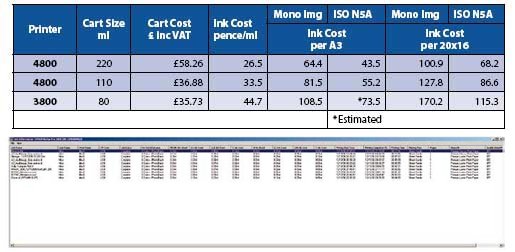articles/Printers/epson3800-page4
Epson Stylus Pro 3800 - part 4 of 1 2 3 4
by Mike McNamee Published

Running Costs
The LFP utility provides data on printing times and ink usage for each print sent through the printer. This is useful for people like us doing costing and utilisation sums but, because the data may be exported as csv format files for use in spread-sheets, it would have benefits for bureaux who wished to both monitor the cost and time taken for different clients' larger runs and in stock-controlling media. We used the data to compute the actual cost of printing. In essence the 3800 costs about 34% more to run than a 4800 using 110ml cartridges and 68% more than a 4800 using 220ml cartridges. A 3800-monochrome print worked out at 0.532p/in2 inclusive of VAT - for the ink only, using the PGPP/2880 setting and assuming a cartridge cost of £35.77 including VAT. This computes to about 108p for an A3 print. In common with other makers, Epson use the ISO SCID N5A Bicycle image as the baseline to compute ink usage. Taking mean luminosity as an indicator of ink use, the ISO image has a luminosity of 70%, compared to the 44% measured on the Paul Gallagher image shown. Given that camera meters assume an average scene luminance of 50% (for that is what an 18% Grey Card is!) then the ISO image is flattering about ink utilisation. In fact the ratios between luminosities and ink usages are within 10% of each other. The bottom line is therefore that a truly average print will cost about £1.00 for ink and £1.22 for media, making £2.20 per A3 a good ballpark figure to work with. Compared to laboratory 20x16 prices for high-quality printing (for this is what we are making) of between £8.70 to £25.85 along with postage of between £7 and £9 (from a web trawl - you might find cheaper deals) then in-house printing has cost benefits providing you have the time to oversee the printing. Compared to the price you should be charging clients for your prints, the ink-jet media costs should be trivial even though it sometimes does not feel like it when you have to lash out over £300 for a set of cartridges.
In view of the cost savings by using a 4800 and 220ml cartridges we did the ROI (return on investment) calculation based on the number of prints. Assuming that the 4800 costs £1,550 and the 3800 costs £1,170 then you have save £380 in cartridge costs to reach the break-even between the 3800 and the more expensive 4800. At 44p saving per A3 print you would be better off after 863 prints (or the equivalent square footage). All else being equal then, the 4800 might be a better bet, but only the individual photographer can make that call. The other dynamic is that once you have sold 800 A3 prints at more than £100 a time (for example), the cost of the printer and ink has paled into insignificance. You might for example judge the ability to switch between matte and photo black inks an overriding benefit.

Conclusion
For the photographer with a need for flawless quality prints from sheet media on both matte and gloss papers the decision is easy, just go out and buy a 3800. If you are tight for space, the same thing applies, they don't come any smaller with this capability. If you need to do canvas even the 4800 is not really big enough and you may have to go up to the 7800 or even the 9800. If you make cards, the 3800 is the natural choice. If you are a fine art printer who makes hundreds of prints then the 4800 will give cost benefits which will pay for the extra cost of either the 4800 or an even larger machine in next to no time. If you are an enthusiast photographer or only an occasional self-printer, the investment in the 3800 and its desk space requirements are all a benefit. If you are a monochrome specialist you have the benefits of the Advanced Black and White drivers and the very low metamerism. The nice thing about the situation is that you can base your decision upon working requirements, safe in the knowledge that any of the printers in the range will produce the quality; any compromises you have to make will be small.
We said we were impressed by the 3800 when we reported on it in the last issue. Having given it a more thorough testing, we are even more impressed. The only (and single) thing that caught us out was when we tried to print from Word. This picked up the default media settings and promptly went into ink switch mode even though we did not wish to - it is a small price to pay, and we won't be doing it again! You can imagine the angst if that had happened on a 4800 with its £45 ink change penalty!
It is going to be interesting to see just how many 3800s are sold. The 16/17" market is big in Europe anyway and the price and size of this printer fits it nicely into the enthusiast market with their print standard of 20x16 inches and their demands for art papers and monochromes. Almost everybody we have shown the review model to has toddled off and bought one, Epson must think Christmas came early!
Please Note:
There is more than one page for this Article.
You are currently on page 4
- Epson Stylus Pro 3800 page 1
- Epson Stylus Pro 3800 page 2
- Epson Stylus Pro 3800 page 3
- Epson Stylus Pro 3800 page 4
1st Published
last update 09/12/2022 14:53:54
More Printers Articles
There are 0 days to get ready for The Society of Photographers Convention and Trade Show at The Novotel London West, Hammersmith ...
which starts on Wednesday 14th January 2026




